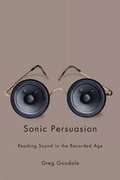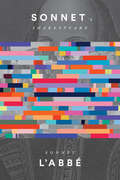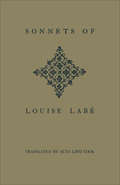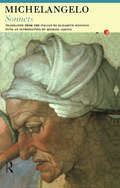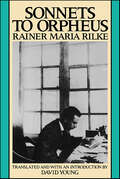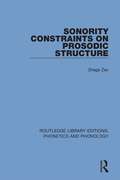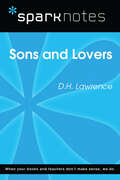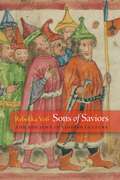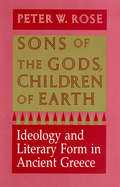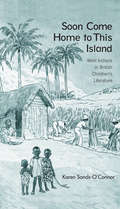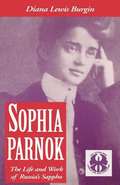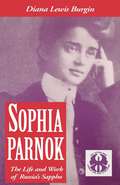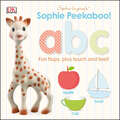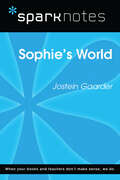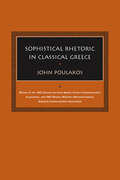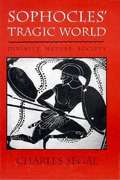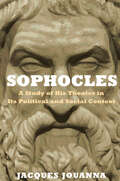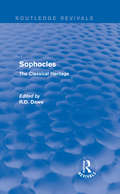- Table View
- List View
Sonic Persuasion: Reading Sound in the Recorded Age
by Greg GoodaleSonic Persuasion: Reading Sound in the Recorded Age critically analyzes a range of sounds on vocal and musical recordings, on the radio, in film, and in cartoons to show how sounds are used to persuade in subtle ways. Greg Goodale explains how and to what effect sounds can be "read" like an aural text, demonstrating this method by examining important audio cues such as dialect, pausing, and accent in presidential recordings at the turn of the twentieth century. Goodale also shows how clocks, locomotives, and machinery are utilized in film and literature to represent frustration and anxiety about modernity, and how race and other forms of identity came to be represented by sound during the interwar period. In highlighting common sounds of industry and war in popular media, Sonic Persuasion also demonstrates how programming producers and governmental agencies employed sound to evoke a sense of fear in listeners. Goodale provides important links to other senses, especially the visual, to give fuller meaning to interpretations of identity, culture, and history in sound.
Sonnet's Shakespeare
by Sonnet L'AbbeBronwen Wallace Memorial Award-winning poet Sonnet L'Abbé returns with her third collection, in which a mixed-race woman decomposes her inheritance of Shakespeare by breaking open the sonnet and inventing an entirely new poetic form.How can poetry grapple with how some cultures assume the place of others? How can English-speaking writers use the English language to challenge the legacy of colonial literary values? In Sonnet's Shakespeare, one young, half-dougla (mixed South Asian and Black) poet tries to use "the master's tools" on the Bard's "house," attempting to dismantle his monumental place in her pysche and in the poetic canon.In a defiant act of literary patricide and a feat of painstaking poetic labour, Sonnet L'Abbé works with the pages of Shakespeare's sonnets as a space she will inhabit, as a place of power she will occupy. Letter by letter, she sits her own language down into the white spaces of Shakespeare's poems, until she overwhelms the original text and effectively erases Shakespeare's voice by subsuming his words into hers. In each of the 154 dense new poems of Sonnet's Shakespeare sits one "aggrocultured" Shakespearean sonnet--displaced, spoken over, but never entirely silenced. L'Abbé invented the process of Sonnet's Shakespeare to find a way to sing from a body that knows both oppression and privilege. She uses the procedural techniques of Oulipian constraint and erasure poetries to harness the raw energies of her hyperconfessional, trauma-forged lyric voice. This is an artist's magnum opus and mixed-race girlboy's diary; the voice of a settler on stolen Indigenous territories, a sexual assault survivor, a lover of Sylvia Plath and Public Enemy. Touching on such themes as gender identity, pop music, nationhood, video games, and the search for interracial love, this book is a poetic achievement of undeniable scope and significance.
Sonnets of Louise Labé
by Alta Lind Cook Louise LabéThe love sonnets of Louise Labé of Lyons and the gilded legend of her life in the early years of the French Renaissance have appealed to the imagination of four centuries.Printed here beside the text of the 1556 edition, the translations of the sonnets by Alta Lind Cook follow closely the original version and admirably retain its sweep and movement, its simplicity and melody. The rhyme scheme of the Petrarchan sonnet has been preserved with variations and corresponding to those of the French. With the poems, the translator presents a sketch of the circumstances and background of this unique literary figure of the Sixteenth Century, known in France and outside of France as La Belle Cordière. These translations by Alta Lind Cook are fine poetry; in English as in French the reader finds "present reality in their hope and their despair, their independence and their impertinence, their tears and their sparkle."
Sonnets of Michelangelo: Michelangelo
by MichelangeloFirst published in 2003. Routledge is an imprint of Taylor & Francis, an informa company.
Sonnets to Orpheus (Wesleyan Poetry in Translation)
by Rainer Maria RilkeSonnets to Orpheus is Rainer Maria Rilke's first and only sonnet sequence. It is an undisputed masterpiece by one of the greatest modern poets, translated here by a master of translation, David Young.Rilke revived and transformed the traditional sonnet sequence in the Sonnets. Instead of centering on love for a particular person, as has many other sonneteers, he wrote an extended love poem to the world, celebrating such diverse things as mirrors, dogs, fruit, breathing, and childhood. Many of the sonnets are addressed to two recurrent figures: the god Orpheus (prototype of the poet) and a young dancer, whose death is treated elegiacally.These ecstatic and meditative lyric poems are a kind of manual on how to approach the world – how to understand and love it. David Young's is the first most sensitive of the translations of this work, superior to other translations in sound and sense. He captures Rilke's simple, concrete, and colloquial language, writing with a precision close to the original.
Sonority Constraints on Prosodic Structure (Routledge Library Editions: Phonetics and Phonology #23)
by Draga ZecFirst published in 1994. The goal of this study is to find the correlations between the internal constituency of the syllable and the sonority of segments. Its major claim is that valid correlations can be established only under the moraic theory of syllable-internal structure. This work thus represents an argument for the moraic theory of the syllable. This title will be of interest to students of language and linguistics.
Sons and Lovers (SparkNotes Literature Guide Series)
by SparkNotesSons and Lovers (SparkNotes Literature Guide) by D.H. Lawrence Making the reading experience fun! Created by Harvard students for students everywhere, SparkNotes is a new breed of study guide: smarter, better, faster.Geared to what today's students need to know, SparkNotes provides:*Chapter-by-chapter analysis *Explanations of key themes, motifs, and symbols *A review quiz and essay topicsLively and accessible, these guides are perfect for late-night studying and writing papers
Sons of Saviors: The Red Jews in Yiddish Culture (Jewish Culture and Contexts)
by Rebekka VoßEnvisioned as a tribe of ruddy-faced, redheaded, red-bearded Jewish warriors, bedecked in red attire who purportedly resided in isolation at the fringes of the known world, the Red Jews are a legendary people who populated a shared Jewish-Christian imagination. But in fact the red variant of the Ten Lost Tribes of Israel is a singular invention of late medieval vernacular culture in Germany. This idiosyncratic figure, together with the peculiar term “Red Jews,” existed solely in German and Yiddish, the German-Jewish vernacular. These two language communities assessed the Red Jews differently and contested their significance, which is to say, they viewed them in different shades of red. The voyage of the Red Jews through the Jewish and Christian imagination, from their medieval Christian nascence, through early modern Old Yiddish literature, to modern Yiddish culture in Eastern Europe, Palestine, and America, is the story of this book.By studying this vernacular icon, Rebekka Voß contributes to our understanding of the formation of minority awareness and the construction of Ashkenazic Jewish identity through visual cultural encounters. She also spotlights the vitality of vernacular culture by demonstrating how the premodern motif of the Red Jews informed modern Yiddish literature, and how the stereotype of Jewish red hair found its way into Jewish social critiques, political thought, and arts through the present day.Sons of Saviors is a story about power: the Yiddish reappropriation of the Red Jews subverted the Christian color symbolism by adjusting the focus on redness from a negative stereotype into a proud badge of self-assertion. The book also includes in an appendix the full text of a significant Yiddish tale featuring the Red Jews.
Sons of the Gods, Children of Earth: Ideology and Literary Form in Ancient Greece
by Peter W. RoseIn this ambitious and venturesome book, Peter W. Rose applies the insights of Marxist theory to a number of central Greek literary and philosophical texts. He explores major points in the trajectory from Homer to Plato where the ideology of inherited excellence—beliefs about descent from gods or heroes—is elaborated and challenged. Rose offers subtle and penetrating new readings of Homer's Iliad and Odyssey, Pindar's Tenth Pythian Ode, Aeschylus's Oresteia, Sophokles' Philoktetes, and Plato's Republic.Rose rejects the view of art as a mere reflection of social and political reality—a view that is characteristic not only of most Marxist but of most historically oriented treatments of classical literature. He applies instead a Marxian hermeneutic derived from the work of the Frankfurt School and Fredric Jameson. His readings focus on illuminating a politics of form within the text, while responding to historically specific social, political, and economic realities. Each work, he asserts, both reflects contemporary conflicts over wealth, power, and gender roles and constitutes an attempt to transcend the status quo by projecting an ideal community. Following Marx, Rose maintains that critical engagement with the limitations of the utopian dreams of the past is the only means to the realization of freedom in the present.Classicists and their students, literary theorists, philosophers, comparatists, and Marxist critics will find Sons of the Gods, Children of Earth challenging reading.
Soon Come Home to This Island: West Indians in British Children's Literature (Children's Literature and Culture #45)
by Karen Sands-O'ConnorSoon Come Home to This Island traces the representation of West Indian characters in British children's literature from 1700 to today. This book challenges traditional notions of British children's literature as mono-cultural by illuminating the contributions of colonial and postcolonial-era Black British writers. The author examines the varying depictions of West Indian islands and peoples in a wide range of picture books, novels, textbooks, and popular periodicals published over the course of more than 300 years. An excellent resource for any children's literature student or scholar, the book includes a chronological bibliography of primary source material that includes West Indian characters and twenty black-and-white illustrations that chart the changes in visual representations of West Indians over time.
Sophia Parnok: The Life and Work of Russia's Sappho
by Diana L. Burgin"The weather in Moscow is good, there's no cholera, there's also no lesbian love... Brrr! Remembering those persons of whom you write me makes me nauseous as if I'd eaten a rotten sardine. Moscow doesn't have them--and that's marvellous." Anton Chekhov, writing to his publisher in 1895. Chekhov's barbed comment suggests the climate in which Sophia Parnok was writing, and is an added testament to to the strength and confidence with which she pursued both her personal and artistic life. Author of five volumes of poetry, and lover of Marina Tsvetaeva, Sophia Parnok was the only openly lesbian voice in Russian poetry during the Silver Age of Russian letters. Despite her unique contribution to modern Russian lyricism however, Parnok's life and work have essentially been forgotten. Parnok was not a political activist, and she had no engagement with the feminism vogueish in young Russian intellectual circles. From a young age, however, she deplored all forms of male posturing and condescension and felt alienated from what she called patriarchal virtues. Parnok's approach to her sexuality was equally forthright. Accepting lesbianism as her natural disposition, Parnok acknowledged her relationships with women, both sexual and non-sexual, to be the centre of her creative existence. Diana Burgin's extensively researched life of Parnok is deliberately woven around the poet's own account, visible in her writings. The book is divided into seven chapters, which reflect seven natural divisions in Parnok's life. This lends Burgin's work a particular poetic resonance, owing to its structural affinity with one of Parnok's last and greatest poetic achievements, the cycle of love lyrics Ursa Major. Dedicated to her last lover, Parnok refers to this cycle as a seven-star of verses, after the seven stars that make up the constellation. Parnok's poems, translated here for the first time in English, added to a wealth of biographical material, make this book a fascinating and lyrical account of an important Russian poet. Burgin's work is essential reading for students of Russian literature, lesbian history and women's studies.
Sophia Parnok: The Life and Work of Russia's Sappho (The Cutting Edge: Lesbian Life and Literature Series)
by Diana L. BurginThe weather in Moscow is good, there's no cholera, there's also no lesbian love...Brrr! Remembering those persons of whom you write me makes me nauseous as if I'd eaten a rotten sardine. Moscow doesn't have them--and that's marvellous."-Anton Chekhov, writing to his publisher in 1895 Chekhov's barbed comment suggests the climate in which Sophia Parnok was writing, and is an added testament to to the strength and confidence with which she pursued both her personal and artistic life. Author of five volumes of poetry, and lover of Marina Tsvetaeva, Sophia Parnok was the only openly lesbian voice in Russian poetry during the Silver Age of Russian letters. Despite her unique contribution to modern Russian lyricism however, Parnok's life and work have essentially been forgotten. Parnok was not a political activist, and she had no engagement with the feminism vogueish in young Russian intellectual circles. From a young age, however, she deplored all forms of male posturing and condescension and felt alienated from what she called patriarchal virtues. Parnok's approach to her sexuality was equally forthright. Accepting lesbianism as her natural disposition, Parnok acknowledged her relationships with women, both sexual and non-sexual, to be the centre of her creative existence. Diana Burgin's extensively researched life of Parnok is deliberately woven around the poet's own account, visible in her writings. The book is divided into seven chapters, which reflect seven natural divisions in Parnok's life. This lends Burgin's work a particular poetic resonance, owing to its structural affinity with one of Parnok's last and greatest poetic achievements, the cycle of love lyrics Ursa Major. Dedicated to her last lover, Parnok refers to this cycle as a seven-star of verses, after the seven stars that make up the constellation. Parnok's poems, translated here for the first time in English, added to a wealth of biographical material, make this book a fascinating and lyrical account of an important Russian poet. Burgin's work is essential reading for students of Russian literature, lesbian history and women's studies.
Sophie la girafe: Peekaboo ABC (Sophie la Girafe)
by DKLearn your alphabet with Sophie! Teach your child all about letters through colorful and familiar objects, from apples to tigers to zebras--with peekaboo surprises to keep your little one's attention!
Sophie's World (SparkNotes Literature Guide Series)
by SparkNotesSophie's World (SparkNotes Literature Guide) by Jostein Gaarder Making the reading experience fun! Created by Harvard students for students everywhere, SparkNotes is a new breed of study guide: smarter, better, faster. Geared to what today's students need to know, SparkNotes provides: *Chapter-by-chapter analysis *Explanations of key themes, motifs, and symbols *A review quiz and essay topicsLively and accessible, these guides are perfect for late-night studying and writing papers
Sophistical Rhetoric in Classical Greece (Studies in Rhetoric & Communication)
by John PoulakosAn expert in rhetoric offers a new perspective on the ancient concept of sophistry, exploring why Plato, Isocrates, and Aristotle found it objectionable.In Sophistical Rhetoric in Classical Greece, John Poulakos argues that a proper understanding of sophistical rhetoric requires a grasp of three cultural dynamics of the fifth century B.C.: the logic of circumstances, the ethic of competition, and the aesthetic of exhibition. Traced to such phenomena as everyday practices, athletic contests, and dramatic performances, these dynamics defined the role of sophistical rhetoric in Hellenic culture and explain why sophistry has traditionally been understood as inconsistent, agonistic, and ostentatious.In his discussion of ancient responses to sophistical rhetoric, Poulakos observes that Plato, Isocrates, and Aristotle found sophistry morally reprehensible, politically useless, and theoretically incoherent. At the same time, they produced their own version of rhetoric that advocated ethical integrity, political unification, and theoretical coherence. Poulakos explains that these responses and alternative versions were motivated by a search for solutions to such historical problems as moral uncertainty, political instability, and social disorder. Poulakos concludes that sophistical rhetoric was as necessary in its day as its Platonic, Isocratean, and Aristotelian counterparts were in theirs.
Sophocles' Philoctetes and the Great Soul Robbery
by Norman AustinNorman Austin brings both keen insight and a life-long engagement with his subject to this study of Sophocles' late tragedyPhiloctetes, a fifth-century BCE play adapted from an infamous incident during the Trojan War. InSophocles' "Philoctetes" and the Great Soul Robbery, Austin examines the rich layers of text as well as context, situating the play within the historical and political milieu of the eclipse of Athenian power. He presents a study at once of interest to the classical scholar and accessible to the general reader. Though the play, written near the end of Sophocles' career, is not as familiar to modern audiences as his Theban plays,Philoctetesgrapples with issues-social, psychological, and spiritual-that remain as much a part of our lives today as they were for their original Athenian audience.
Sophocles' Tragic World: Divinity, Nature, Society
by Charles SegalIn a series of engagingly written interconnected essays, Segal studies five of Sophocles' seven extant plays: Ajax, Oedipus Tyrannus, Philoctetes, Antigone, and the often neglected Trachinian Women.
Sophocles: A Study of His Theater in Its Political and Social Context
by Jacques JouannaHere, for the first time in English, is celebrated French classicist Jacques Jouanna's magisterial account of the life and work of Sophocles. Exhaustive and authoritative, this acclaimed book combines biography and detailed studies of Sophocles' plays, all set in the rich context of classical Greek tragedy and the political, social, religious, and cultural world of Athens's greatest age, the fifth century.Sophocles was the commanding figure of his day. The author of Oedipus Rex and Antigone, he was not only the leading dramatist but also a distinguished politician, military commander, and religious figure. And yet the evidence about his life has, until now, been fragmentary.Reconstructing a lost literary world, Jouanna has finally assembled all the available information, culled from inscriptions, archaeological evidence, and later sources. He also offers a huge range of new interpretations, from his emphasis on the significance of Sophocles' political and military offices (previously often seen as honorary) to his analysis of Sophocles' plays in the mythic and literary context of fifth-century drama.Written for scholars, students, and general readers, this book will interest anyone who wants to know more about Greek drama in general and Sophocles in particular. With an extensive bibliography and useful summaries not only of Sophocles' extant plays but also, uniquely, of the fragments of plays that have been partially lost, it will be a standard reference in classical studies for years to come.
Sophocles: The Classical Heritage (Routledge Revivals)
by Roger DaweSophocles: The Classical Heritage, first published in 1996, contains a diverse collection of reflection, ranging from the 16th century to the 20th, on one of the three great Attic tragedians, the author of perhaps the most famous play of all time. With the entire notion of ‘Western culture’ under duress, the need to establish continuity from antiquity to modernity is as pressing as ever. Each essay, selected by Professor Dawe, explores a theme or concept derived from the tragic vision of the Sophoclean universe which is still of relevance today. An enormous range of topics is investigated, in a variety of modes and styles: the linguistic challenges of translation, the psychology of Sigmund Freud, Enlightenment critiques, the history of performance conventions, dramatic structure and technique, and issues facing the modern director. Overall, Professor Dawe offers a staggering selection of responses, which cumulatively demonstrate the continuing importance and fascination of Sophocles’ legacy.
Sophocles: The Theban Plays (Cambridge Greek And Latin Classics Ser.)
by SophoclesLinked by their common setting in Thebes, Antigone, Oedipus the King, and Oedipus at Colonus stand at the fountainhead of world drama. This volume presents a new, and accurate yet poetic and playable translation by playwright Don Taylor, who has also directed plays for a BBC-TV production.
Sor Juana Inés de la Cruz and the Gender Politics of Knowledge in Colonial Mexico (New Hispanisms: Cultural and Literary Studies)
by Stephanie KirkEach of the book's five chapters evokes a colonial Mexican cultural and intellectual sphere: the library, anatomy and medicine, spirituality, classical learning, and publishing and printing. Using an array of literary texts and historical documents and alongside secondary historical and critical materials, the author Stephanie Kirk demonstrates how Sor Juana used her poetry and other works to inscribe herself within the discourses associated with these cultural institutions and discursive spheres and thus challenge the male exclusivity of their precepts and precincts. Kirk illustrates how Sor Juana subverted the masculine character of erudition, writing herself into an all-male community of scholars. From there, Sor Juana clearly questions the gender politics at play in her exclusion, and undermines what seems to be the inextricable link previously forged between masculinity and institutional knowledge. Sor Juana Inés de la Cruz and the Gender Politics of Knowledge in Colonial Mexico opens up new readings of her texts through the lens of cultural and intellectual history and material culture in order to shed light on the production of knowledge in the seventeenth-century colonial Mexican society of which she was both a product and an anomaly.
Sorcery & Cecelia: Or, The Enchanted Chocolate Pot (The Cecelia and Kate Novels #1)
by Patricia C. Wrede Caroline StevermerTwo young ladies contend with the Royal College of Wizards in Regency London: First in the series filled with &“magical twists and turns&” (San Diego Union-Tribune). Since they were children, cousins Kate and Cecelia have been inseparable. But in 1817, as they approach adulthood, their families force them to spend a summer apart. As Cecelia fights boredom in her small country town, Kate visits London to mingle with the brightest lights of English society. At the initiation of a powerful magician into the Royal College of Wizards, Kate finds herself alone with a mysterious witch who offers her a sip from a chocolate pot. When Kate refuses the drink, the chocolate burns through her dress and the witch disappears. It seems that strange forces are convening to destroy a beloved wizard, and only Kate and Cecelia can stop the plot. But for two girls who have to contend with the pressures of choosing dresses and beaux for their debuts, deadly magic is only one of their concerns. This ebook features illustrated biographies of Patricia C. Wrede and Caroline Stevermer including rare photos and never-before-seen documents from the authors&’ personal collections.
Sordid Images: The Poetry of Masculine Desire
by Steve ClarkIn this extraordinary and bold book, S.H. Clark explores and constructs a history of poetic misogyny. For the first time, a wide range of English poetry by men is examined for evidence of the articulation of heterosexual masculine desires. But Clark goes beyond a straightforward oppositional model of reading the male canon, to ask how we read this work 'after feminism', and whether it is possible to value these texts as misogynist texts in the light of feminist theory? Sordid Images is a challenging, controversial book. It will excite and unsettle its readers, and inspire many to look again at some of the cornerstone works of English literature.
Soren Kierkegaard (SparkNotes Philosophy Guide)
by SparkNotesSoren Kierkegaard (SparkNotes Philosophy Guide) Making the reading experience fun! SparkNotes Philosophy Guides are one-stop guides to the great works of philosophy–masterpieces that stand at the foundations of Western thought. Inside each Philosophy Guide you&’ll find insightful overviews of great philosophical works of the Western world.
Sorry, No English: 50 Tips to Improve your Communication with Speakers of Limited English
by Craig StortiHave you ever struggled to communicate with a limited-English speaker? Have you been frustrated by unsuccessful interactions with non-native English speakers? Did you know there is a simple solution to improve cross-cultural communication in English?What most of us native speakers overlook in these situations is that the problem here may not be the limited English of the other person; it could be our English. And while we certainly can't do anything about the former, we can do a great deal about the latter.This short book gives 50 practical tools to help you become aware of and adapt your own language to completely transform exchanges with limited-English speakers and greatly increase the chances of a satisfying outcome for both you and the limited-English speaker you're trying to help or serve. And the good news is: it is not that difficult and it is entirely in the hands of the native speaker.Craig Storti is a nationally known figure with over 30 years of experience in the field of intercultural communications and cross-cultural adaptation, and the author of several standard works, including Culture Matters, a cross-cultural workbook used by the U. S. government in over 90 countries. He has successfully led workshops on cultural diversity for Fortune 500 companies, hotels such as Marriott, diplomats, civil servants, and foreign aid workers. But it was his 90-minute segments on common mistakes native speakers make when talking to limited-English speakers and how participants could improve interactions that became the most popular and useful aspect of his training. This much-needed book is ideal for anyone working in a public-facing job from government to hospitality, health care, international organizations, human resources, cross-cultural and diversity training, English as a second language teaching, foreign aid, or those with a love of language, culture and communication.
